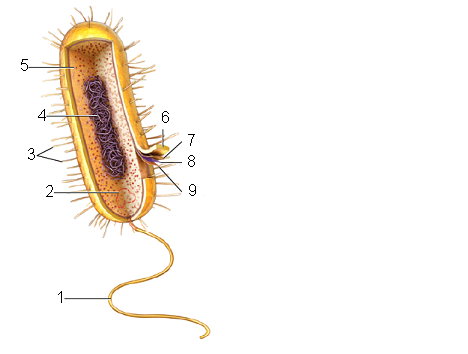A) 1
B) 2
C) 3
D) 4
E) 5
G) C) and D)
Correct Answer

verified
Correct Answer
verified
True/False
Chlamydias are bacteria that possess cell walls, but lack peptidoglycan .
B) False
Correct Answer

verified
Correct Answer
verified
Multiple Choice
Answer the question using the accompanying figure. Which branch of this phylogenetic tree identifies Eukarya?
A) A
B) B
C) C
D) D
E) E
G) None of the above
Correct Answer

verified
Correct Answer
verified
Essay
Differentiate between endotoxins and exoenzymes.
Correct Answer

verified
Endotoxins are lipopolysaccharides released when a bacterium dies and lyses. These lipopolysaccharides cause disease. Exoenzymes are proteins released by some bacteria that can rupture host cells or digest extracellular materials such as collagen.
Correct Answer
verified
Multiple Choice
Answer the question using the accompanying figure. Which number identifies the structure that carries out protein synthesis?
A) 2
B) 4
C) 5
D) 6
E) 9
G) A) and D)
Correct Answer

verified
Correct Answer
verified
True/False
Genome sequence comparisons have now shown that the Korarchaeota are most likely a sister group of the Euryarchaeota.
B) False
Correct Answer

verified
Correct Answer
verified
Multiple Choice
Which symptom indicates the presence of plaque in a dental patient?
A) Presence of E. coli in the patient's mouth.
B) A bacterial culture from a patient's mouth that appears pink after Gram staining.
C) Presence of cyanobacteria in the patient's mouth.
D) A bacterial culture from the patient's mouth that appears purple after Gram staining.
E) Non-pathogenic biofilms in the patient's mouth.
G) B) and D)
Correct Answer

verified
B
Correct Answer
verified
Multiple Choice
The presence of a nuclear membrane is characteristic of ____.
A) Archaea only
B) Bacteria only
C) both Archaea and Bacteria
D) neither Archaea nor Bacteria
E) Archaea, Bacteria and Eukarya
G) A) and C)
Correct Answer

verified
Correct Answer
verified
Multiple Choice
The correct sequence of reagents used in the Gram stain technique is ____.
A) iodine, alcohol, safranin, and crystal violet
B) safranin, crystal violet, alcohol, and iodine
C) crystal violet, iodine, alcohol, and safranin
D) crystal violet, alcohol, iodine, and safranin
E) alcohol, iodine, crystal violet, and safranin
G) D) and E)
Correct Answer

verified
Correct Answer
verified
Matching
Match each prokaryotic genus with its correct description.
Correct Answer
Multiple Choice
How long does it take for a biofilm to form?
A) seconds to minutes
B) minutes to hours
C) hours to days
D) days to months
E) months to years
G) A) and C)
Correct Answer

verified
Correct Answer
verified
True/False
Organisms that live optimally in cold temperatures are called barophiles .
B) False
Correct Answer

verified
Correct Answer
verified
Multiple Choice
Prokaryotic cells generally reproduce by ____.
A) mutation
B) binary fission
C) conjugation
D) transduction
E) transformation
G) C) and E)
Correct Answer

verified
Correct Answer
verified
Matching
Match each prokaryotic genus with its correct description.
Correct Answer
Multiple Choice
Dormant structures formed by certain bacteria in response to unfavorable environmental conditions are called ____.
A) capsids
B) endospores
C) endotoxins
D) exotoxins
E) heterocysts
G) None of the above
Correct Answer

verified
Correct Answer
verified
Multiple Choice
The ____ use solar energy and organic molecules as their nutritional sources.
A) chemoautotrophs
B) chemoheterotrophs
C) photoautotrophs
D) photoheterotrophs
E) Archaea
G) C) and E)
Correct Answer

verified
Correct Answer
verified
Multiple Choice
There are ____ major evolutionary groups in the domain Bacteria.
A) 2
B) 3
C) 4
D) 5
E) at least 6
G) B) and E)
Correct Answer

verified
Correct Answer
verified
Multiple Choice
 Figure 26.1
Answer the question using the accompanying figure. Which type of cell is represented in this figure?
Figure 26.1
Answer the question using the accompanying figure. Which type of cell is represented in this figure?
A) a Gram-positive bacterium
B) a Gram-negative bacterium
C) either a Gram-positive or a Gram-negative bacterium
D) an archaeal cell
E) any prokaryotic cell
G) A) and E)
Correct Answer

verified
Correct Answer
verified
Multiple Choice
Answer the question using the accompanying figure. Which number identifies a structure that is composed of polysaccharides?
A) 1
B) 3
C) 6
D) 7
E) 9
G) A) and E)
Correct Answer

verified
C
Correct Answer
verified
Multiple Choice
The lipopolysaccharides are associated with the ____ membrane of Gram- ____ bacteria.
A) outer; positive
B) outer; negative
C) plasma; positive
D) plasma; negative
E) plasma; positive and negative
G) None of the above
Correct Answer

verified
Correct Answer
verified
Showing 1 - 20 of 100
Related Exams